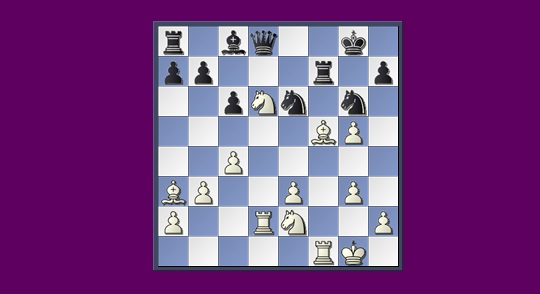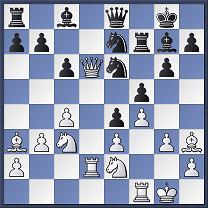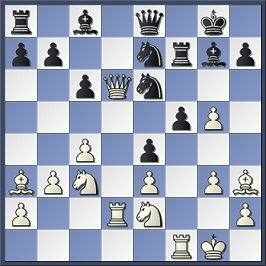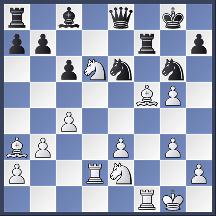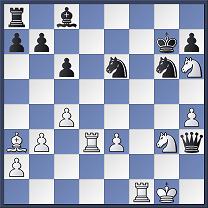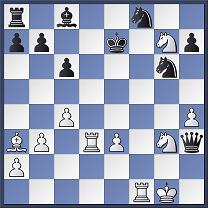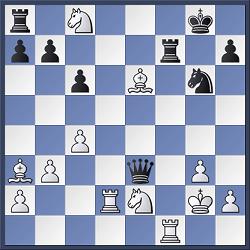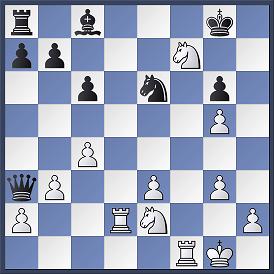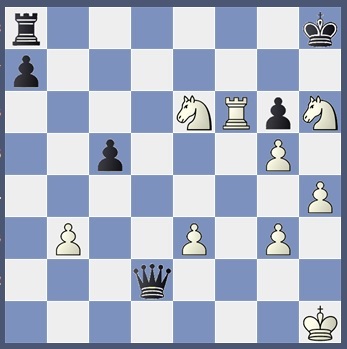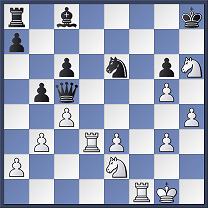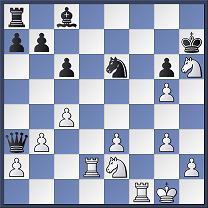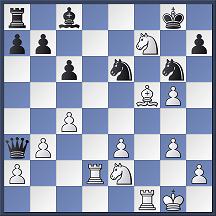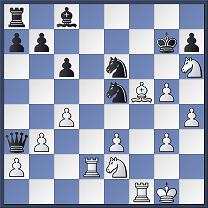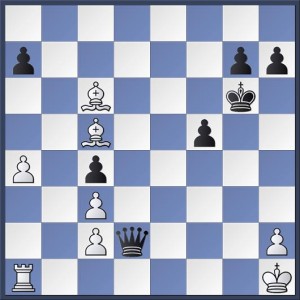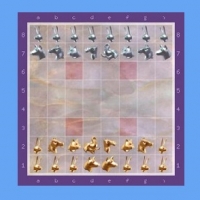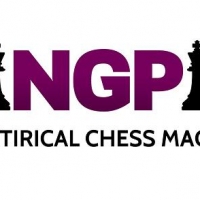James Plaskett
 Complex games may demand intense scrutiny. Thirty-seven years after this one was played in the penultimate round of the world’s most prestigious Open, I offer my final verdict. Early in 2023, Shirov contacted me to say that analysis with Stockfish 15 had revealed to him some quite unexpected lines in our game from Reykyavik 1992 after the superior 17…Be6.
Complex games may demand intense scrutiny. Thirty-seven years after this one was played in the penultimate round of the world’s most prestigious Open, I offer my final verdict. Early in 2023, Shirov contacted me to say that analysis with Stockfish 15 had revealed to him some quite unexpected lines in our game from Reykyavik 1992 after the superior 17…Be6.
Plaskett – Miles
Lugano 1986
1 c4 e5 2 e3 d6 3 Nc3 g6 4 g3 Bg7 5 Bg2 Ne7 6 d4 0-0 7 Nge2 Nd7 8 0-0 f5 9 dxe5 dxe5 10 b3 c6 11 Ba3 Qe8 12 f4 e4 13 Qd6 Rf7 14 Rad1 Nf8 15 Rd2 Ne6 16 Bh3
16…g5!
17 Nxe4? now loses to 17…g4. If instead of 16…g5! he had played 16…Bf8? that would not have stopped the threat, viz 17 Nxe4 Nd5 18 cxd5 Bxd6 19 Nxd6 and White wins.
17 fxg5!?
The fun begins. With 17 Rdd1 White would have kept it level. And safe. And dull.
17…Ng6
17…Bf8 allows 18 Nxe4! Ng6 (18…fxe4 19 Bxe6) and now White only has 19 Bxf5!. But that takes us back into the game.
18 Bxf5! Bf8
A critical point.
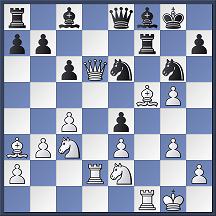 White has 19 Bxg6!? resulting in a mess after, say, 19…Rxf1+ 20 Kxf1 Qxg6 21 Qe5 Bxa3 22 Nxe4. The line 22…Be7 23 h4 Qg7 24 Nf6+ Kh8 25 Nf4 Nxf4 26 Rd8+! Bf8 27 Rxf8+! Qxf8 28 Nd7+ Qg7 29 Qe8+ Qg8 30 Qe5+ is perhaps representative.
White has 19 Bxg6!? resulting in a mess after, say, 19…Rxf1+ 20 Kxf1 Qxg6 21 Qe5 Bxa3 22 Nxe4. The line 22…Be7 23 h4 Qg7 24 Nf6+ Kh8 25 Nf4 Nxf4 26 Rd8+! Bf8 27 Rxf8+! Qxf8 28 Nd7+ Qg7 29 Qe8+ Qg8 30 Qe5+ is perhaps representative.
On 19 Bxg6 Black also had 19…hxg6 when 20 Qe5 Bxa3 21 Nxe4 leaves White comfortably placed and with three healthy pawns for his minor piece.
A more challenging line would be 20…Rxf1+ 21 Kxf1 Qf7+ 22 Kg1 Bxa3 23 Nxe4.
Now 23…Be7 24 Nf6+ Bxf6 25 gxf6 Bd7 26 e4 is about equal and 23…Qf5 24 Nf6+ Kf7 25 Qxf5 gxf5 26 h4 Be7 27 Nd7 is too.
Stockfish 14 proposes 23…Qc7 and ascribes to Black maybe the slightest of pluses.
Instead, I preferred to make it a game featuring a speculative queen sacrifice!
19 Nxe4!? Bxd6 20 Nxd6
a) 20…Qd7? is worst for after 21 Nd4 he must bail out with 21…Rxf5 but then 22 N4xf5 gives an overwhelming attack.
b) 20…Qf8 allows 21 Nxc8 Qxc8 (21…Qxa3? 22 Bxe6 wins) 22 Nd4 when again he must go 22…Rxf5 and 23 Nxf5 leaves no better way of meeting the check at h6 than 23…Nxg5 when there is a draw by knight checks since after 24 Nh6+ Kh8 is not possible because 25 Bb2+ mates and neither is 26…Kf7 because 27 Nd6+ wins the queen.
c) He chose 20…Qd8. Now 21 Nxf7? Qxd2 would leave White unable to check on the long diagonal and so quite lost and 21 Nxc8? fails to 21…Qxd2 22 Bxe6 Qxe3+.
But I unpinned with 21 Rd3!. Now 21…Rf8 22 Nxc8 Qxc8 23 Nd4! forces the repetition given in b) by 23…Rxf5 as 23…Re8? loses to 24 Nxe6 Rxe6 26 Rd8+!! Qxd8 27 Bxe6+ Kg7 28 Rf7+ Kg8 29 Rc7+ Kh8 30 Bb2+ and mate.
I think Miles missed that his 21…Rxf5 could be met by 22 Nxf5! when he should have taken the rook and a draw: 22…Qxd3! 23 Nh6+ Kh8! 24 Bb2+ Ng7 25 Nf7+, etc.
Instead he played 22…Qxg5?, after which he is lost. 23 h4 Qh5?!
The computer´s winning reply to 23…Nxh4 is 24 Ne7+! Kg7 25 e4!
Not the sort of continuation one would be likely to sight upon short of time over the board, but defensible via concrete analysis.
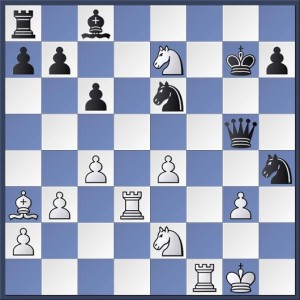 Black is up queen for rook and pawn but has no adequate defence.
Black is up queen for rook and pawn but has no adequate defence.
On 25…Qa5 26 Bb2+ Kh6 27 Ng8+! Kh5 28 gxh4 with raging attack.
On 25…Nc5 26 Bb2+ Kh6 27 Bc1 Nxd3 28 Bxg5+ Kxg5 29 gxh4+ Kxh4 30 Rf8 wins, or 27…Qxc1 28 Rd6+ wins.
On 25…Qg4 26 Bb2+ Kh6 27 Rf6+ Kh5 28 Bc1 and the king is netted. The ending following 28…Ng6 29 Rf5+ Ng5 30 Rxg5+ Qxg5 31 Bxg5 Kxg5 32 Nxg6 is easily won.
Or 27…Ng6 27 Ng8+! Kg7! Best chance; on 27…Kh5 28 Rf5+ wins instantly. 28 Rf4+ Nd4 29 Rxg4 Bxg4 30 Nxd4 Kxg8 and the white initiative continues with, as Kasparov always pointed out, the big plus of getting a knight to f5 in front of a king. 31 Nf5, Decisive. 31…Bxf5 32 exf5 Nf8 33 g4 and wins.
And on 25…Ng6 26 Bb2+ Ne5 (or 26…Kh6 27 Ng8+ Kh5 28 Nf6+ Kh6 29 Bc1 wins.) 27 Nf5+ Kf6 28 Rd6 and Black is so trussed that White will regain his material. Black has nothing more constructive than 28…a5 29 Nf4 a4 30 b4 a3 31 Bc3 Qg4 32 c5 h5 33 Kh1. White can time it as suits him. 33…Qg5 34 Nd3. Now he´s ready. 34… Kf7 35 Nxe5+ Ke8 36 Rd3 with full material equality and winning attack.
24 g4!!
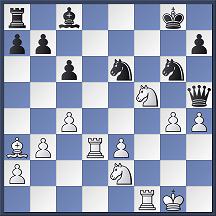 24…Qxg4+ 25 Neg3 Qh3 (forced) 26 Nh6+ Kg7
24…Qxg4+ 25 Neg3 Qh3 (forced) 26 Nh6+ Kg7
Here 27 Ngf5+ was the most natural and 27…Kf6 28 Bb2+ Ne5 permits White wins by 29 Ng8+, 29 Ng3+.
Or even the snazzy 29 e4!! Qxd3 30 Ng4+ and 31 Nxe5+ and 32 Nxd3.
I blundered again with
27 Nhf5+?
which allowed an escape with 27…Kf7! Then it ought to end with something like 28 Nh6+ Ke8 29 Ne4 c5! and, with his potent bishop locked out, White has only perpetual.
27…Kf6?
was the last error and it ended
28 Nh5+ Ke5 (or 28…Kf7 29 Nh6+ Ke8 30 Nf6 mate) 29 Nfg3 Nef8 30 Bb2+
30 Bd6+ also mated in four.
30…Ke6 31 Ng7+ Ke7 32 Ba3+ 1-0
Kasparov cited his 1980 game with Marjanovic as an instance of how it can be worth a pawn to establish a knight at f5 in front of the opponent’s king. He also told me the 16th game of his 1985 match with Karpov illustrated how the influence of a knight at d3 (d6) supported by a bishop may compensate for sacrificed material.
But there was also
ci) 21…Qa5!? I gave 22 b4 Qe5 23 Nxf7 Kxf7 24 Bxe6+ Kxe6 25 b5! c5 26 Nc3 ‘. . . and Black’s chances of survival are slim’, in Starting Out: Attacking Play (Everyman 2004).
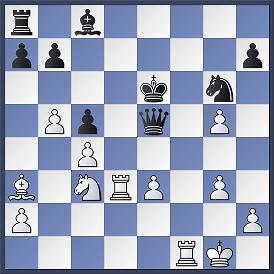 Stockfish 14 took a more sanguine view. Black gets slaughtered after 26…b6 27 Bb2!, e.g. 27…Qxg5 28 Ne4, e.g. 28…Qg4 29 Rd6+ Ke7 30 Bf6+ Kf7 31 Ng5+ Kg8 32 Rd8+ Nf8 33 Be7 or reaches a clearly worse ending after 27…Bb7 28 Rf6+ Qxf6 (28…Ke7 29 Nd5+) 29 gxf6 Ne5 30 Rd1 Nxc4 31 Ba1.
Stockfish 14 took a more sanguine view. Black gets slaughtered after 26…b6 27 Bb2!, e.g. 27…Qxg5 28 Ne4, e.g. 28…Qg4 29 Rd6+ Ke7 30 Bf6+ Kf7 31 Ng5+ Kg8 32 Rd8+ Nf8 33 Be7 or reaches a clearly worse ending after 27…Bb7 28 Rf6+ Qxf6 (28…Ke7 29 Nd5+) 29 gxf6 Ne5 30 Rd1 Nxc4 31 Ba1.
But 26…Bd7! is tougher. 27 Rf6+ (27 Nd5 Rf8 28 Rfd1 may also yield sufficient play for White, but I prefer this.) 27…Ke7 28 Nd5+ and
cia) 28…Ke8 29 Bxc5 wins a fourth pawn with the Black king still under harassment.
29…Bh3 (threatening mate) 30 Rd4 (threatening the queen) 30…Rd8 31 Bd6! Rxd6 32 Rxd6 is one plausible and obscure continuation.
cib) On 28…Kd8 29 Bxc5 Rc8 30 Bxa7 is a useful grab and also increases White’s attack potential. After 30…Rxc4 31 Rd1 there is the delightful line, 31…Bxb5 32 Nb6+ Kc7?? 33 Bb8+!!, indicating how useful Short’s favourite (Bxa7) may be.
31…Bg4 is better and after 32 Bd4 Qe8 33 Rd6+ Kc8 34 Nb6+ Kb8 35 Nxc4 Bxd1 36 Bb6 we get an ending where White is not worse.
So 21…Qa5 was as good as 21…Rxf5.
d) 20…Qe7! was the refutation I gave in 2004. Whilst it is certainly the option to challenge White the most, even Stockfish 14 cannot affirm with certainty that Black emerges on top. But, as you will see, the variations and resultant positions are far from usual.
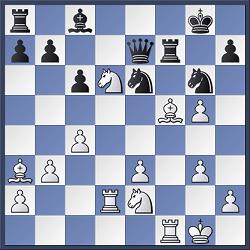 If 21 h4 Rxf5 wins: White must take something.
If 21 h4 Rxf5 wins: White must take something.
da) 21 Nxc8
db) 21 Nxf7
da) 21 Nxc8
We both rejected 20…Qe7! because of 21 Nxc8 Qxa3 22 Bxe6, transposing to a line given in the notes to b) 20…Qf8.
But Black has 21…Qxg5! and the tables are spectacularly turned, e.g. 22 Bxe6 Qxe3+
dai) 23 Kg2
daii) 23 Kh1
dai) 23 Kg2
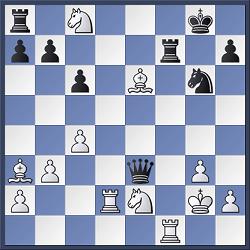 In Playing To Win (Batsford 1988) I said 23…Qxe6 24 Rd8+ Kg7 25 Bb2+ Kh6 26 Bc1+ Kh5 wins.
In Playing To Win (Batsford 1988) I said 23…Qxe6 24 Rd8+ Kg7 25 Bb2+ Kh6 26 Bc1+ Kh5 wins.
But this is wrong as 26 Rxf7! holds. ‘Playing to win’ would now fail, e.g. 26…Qxf7 27 Bc1+ Kh5? (27…Kg7 28 Bb2+ repeats) loses to 28 Rd4!, when White threatens 29 g4+ Kh4 30 g5+ Kh5 31 Ng3 mate, and 28…Rxc8 29 g4+ Kh4 30 g5+ forces a won ending after 30…Nf4+ 31 Rxf4+. So better to take the knight with 26…Qxe2+ 27 Rf2.
Black cannot wait whilst White moves his king up and mates him so 31…Qxh3 is best, and then 32 Rh2 Qxh2+ 33 Kxh2… creates mating ideas of Kh3 and g4 and White will retain a tiny plus after 33…Kg4 34 Kg2.
Or 30…Qe4 31 Rdf6 Rxc8 White draws by 32 R/6-f5+ Kg4 33 Rg5+ Kh3 34 Rh5+ etc.
Another draw results from 30…Qe1+ 31 Rf1 Qe5 32 Rf7! when Black ought to check on e1. 32…Rxc8? 33 Rxh7+ Kg4 34 Rxg6+ would leave Black behind on material and 32…Kg4? meets the spectacular 33 h3+!!
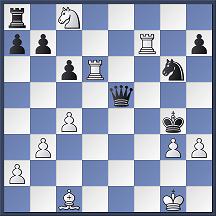 Disruptive knight sacs also do not work either, viz 27…Nf4+ 28 gxf4 Qg4+ 29 Kf1 Rxc8 and White is not worse following 30 Rd3 nor 30 Rxc8 Qxc8 31 f5.
Disruptive knight sacs also do not work either, viz 27…Nf4+ 28 gxf4 Qg4+ 29 Kf1 Rxc8 and White is not worse following 30 Rd3 nor 30 Rxc8 Qxc8 31 f5.
Or 27…Nh4+? 28 gxh4 Qg4+ 29 Kh1 Rxc8 is losing to 30 Rf6+ Kh5 31 Rd4! Qe2 32 Rf5+ Kg6 33 Rg5+ Kf7 (33…Kh6 34 Rd6+) 34 Rf4+ Ke6 35 Re5+ Qxe5 36 Bxe5 Kxe5 37 Rf7.
db) 21 Nxf7 Qxa3
(21…Qxf7? 22 Bxe6 Qxe6 23 Rd8+ Kg7 24 Bb2+ Ne5 25 Nd4 is devastating, e.g. 25…Qe7 26 Rxc8).
Three pawns and a rook for the queen is near equality. But those are coarse guidelines for so delicate a setting. Black’s king is exposed, his queen out of it and his queenside undeveloped. Meanwhile White’s rooks and knights lurk as immanent attackers, the pawn at g5 may have an attacking role as well as serving as an anchor, and sometimes even the h pawn gets in on the act. For Black, a queen is a queen and one of its especial fortes is circling to exploit discoordination and weaknesses.
 In 1988 I thought this unclear. Then in 2004 I said that after 22 Bxg6 hxg6 23 Nh6+ Kh8 White was lost.
In 1988 I thought this unclear. Then in 2004 I said that after 22 Bxg6 hxg6 23 Nh6+ Kh8 White was lost.
The position is unique and, although it merits the signs for ‘development advantage’, ‘initiative’, ‘attack’ and ‘compensation for the material’, the playing fields are strewn with mines and ultimately concrete analysis is what counts.
White’s rook and three pawns are materially not quite sufficient in themselves. And, since f7 hangs, the first impulse is to take on g6.
But, as Stockfish 14 now is to argue, it’s not best.
db1) 22 Bxg6 hxg6
Essentially Black can try to get his act together in three ways: slotting the knight to g7, breaking out with …b5, or pulling the queen back.
db1a) 23…Kh8
After 24 Rf7+ Ng7.
If now 25 h4 Black repels with 25…Be6! when 26 Rxb7 Re8 creates the big threat of 27…Qa6 28 Rc7 Qa5 or 28…Qb6.
26 Rg8 Otherwise g5 is taken, or 26 Rff8 Qe1+ 27 Kg2 Bh3+ and wins.
26… Qe1+ 27 Rf1 Qxf1+! (27…Qxe2 28 Rxg7+! draws immediately.) 28 Kxf1 Bh3+ 29 Kf2 Rxg8 30 Nxg8 Kxg8
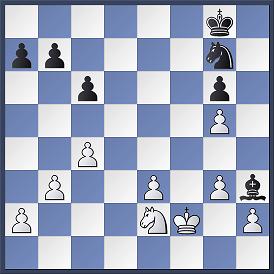 White just cannot get it together. He may try
White just cannot get it together. He may try
db1bi) 31 Nf4
db1bii) 31 Kf3
db1bi) 31 e4
db1bi) 31 Nf4 Bf5 32 Kf3 Bb1 33 a3 Kf7 34 b4 Ne8! The knight sets off to attack. White cannot save this, not even by advancing his pawn clump, e.g. 35 c5 Nc7 36 g4 Nb5 37 h4 Nxa3 38 h5 Nc4, etc.
Or 32 c5 Bb1 33 a3 Ne8 34 g4 Nc7 35 h4 Nb5 36 h5 Nxa3 37 Kf3 Nb5 similarly.
db1bii) 31 Kf3 White has up his sleeve the tricky device of g3-g4 confining the bishop. Black must play accurately. 31…Ne6 Essential: on anything else White
straightens out his kingside pawns. 32 g4 Nxg5+ 33 Kg3 Bf1 34 Nf4 Ne4+ 35 Kf3 Nd2+! 36 Kf2 g5! 37 Ne6 Bd3 38 Nxg5 c5! and White is struggling.
The other try to confine the bishop behind enemy lines is 34 Nc1. Now black may deploy the extraordinary device of 34…Nh3!
If White twiddles his thumbs the black king advances rapidly. But on 35 b4 the prison door is opened and Black just nips back with his knight to stand winning after 35…Ng5.
An entirely different notion is simply to head towards the black pawns by 32 Ke4 Nxg5+ 33 Ke5. Here Stockfish 14 regards Black as clearly on top with either 33…Kf7 34 Kd6 Ne4+ 35 Kc7 b5 or 33…Nf3+ 34 Kd6 Nxh2 35 Kc7 Bf1 36 Nd4… (36 Nf4? Kf7 and …g5 wins the knight.) 36…c5 37 Ne6 Bg2 38 Nxc5 Nf1
db1biii) 31 e4 (This seemed to me the best chance.) 31…Ne6! (The only move. Against 31…Kf7 White plays 32 Nf4 and 33 h4 with a viable game.) 32 Nf4 Nxg5 (Once again the only way) 33 Nxg6 Kf7 34 Nf4 Nxe4+ 35 Ke3 Ng5
White has succeeded in liquidating the black kingside and now with two connected outside passed pawns for a piece and the black rook pawn the ‘wrong’ one for the bishop he still retains some hope following 36 c5.
Stockfish 14 thinks not after 36…Bf5.
So 23…Kh7! would win.
I looked at 21 Nxf7 Qxa3 as a response to 20…Qf8 and thought only of 22 Bxg6 hxg6 23 Nh6+.
db2) 22 Nh6+ Kg7 (22…Kh8 23 Bxg6 hxg6 24 Rf7 takes us into territory already reconnoitred. As would 23…Qc5 24 Rd3.)
g5 is now en prise and 23 Bxg6? fails to 23…Nxg5!.
(Well, I guess that’s how we refute: the machine prefers 23…Qc5 !!?)
So 23 h4 and some complex lines follow, viz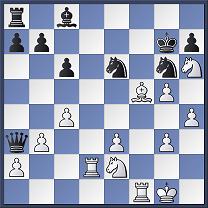 db2a) 23…Qc5
db2a) 23…Qc5
db2b) 23…Qa5
db2c) 23…Qe7
db2d) 23…Ne5
db2a) 23… Qc5 24 Nd4 Qe5 25 Kh2 and we gravitate towards a kind of compensation that white will often obtain in positions stemming from 22 Nh6+ Kg7 23 h4, where his coordinating pieces and advanced pawns near the black king grant him a dynamic equality, e.g. 25… Nxd4 26 exd4 Qe8 27 Rdf2.
Also after 23…Qc5 24 Nd4 Kh8 would be rational, when white may repeat by checking at f7 and h6 as 25 Nf7+ Kg7? loses to 26 Bxe6.
db2b) 23…Qa5 again there is the ‘disobliging interference move’ of 24 Rd6! Now if 24…Nef8 25 Bxg6. On 24…Ngf8 25 Bh3 with an excellent game. And on 24…Qe5 White has 25 Bxg6! Qxe3+ 26 Kh1 hxg6 (26…Qxe2? 27 Bd3) 27 Rf7+ Kh8 28 Nf4 and again black must avail himself of perpetual..
db2c) 23…Qe7 24 Kh2… To avoid tricks at e3.
He would like to swing his knight into the game, but 24 Nf4 allows 24…Nxf4 and 25…Nf3+! 26 Rxf3 Qc1+. So I had had it in mind to cover f3 with 24 Be4, but after 24…Qa5 25 Rfd1 with even so plebeian a move as 25…Rb8 Black may challenge White to show something before the other guy organises.
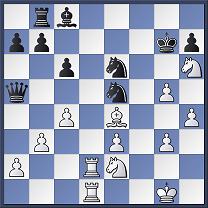 Again 26 Nf4 runs into an inconvenient counter; 26…Nxf4 27 gxf4 Qc3!, e.g. 28 Kf2 Ng4+ 29 Nxg4 Bxg4 30 Bf3 Bxf3 and wins.
Again 26 Nf4 runs into an inconvenient counter; 26…Nxf4 27 gxf4 Qc3!, e.g. 28 Kf2 Ng4+ 29 Nxg4 Bxg4 30 Bf3 Bxf3 and wins.
So 26 Kh1 to prepare, but then 26…Nf8 and Black is ready to complete development. Neither 27 Nd4 Ng4 28 Ndf5+ Bxf5 29 Nxf5+ Kh8 nor 27 Rd8 Qc7 28 Nf4 Bg4 will suffice for White, e.g. here 29 Rxf8 Rxf8 30 Nxg4 Rxf4! 31 exf4 Nxg4 and wins.
There is also the full retreat by 24 Bb1 when Black continues 24…Qa5 25 Rdd1 Nf8.
 If White cannot do something quickly Black will bring out his pieces and stand better or simply winning. Yet even his greatest irritations here still won’t do; 26 Nf4 Bd7 27 Nd3 Nxd3 28 Rxd3 Be6! and he cannot cause enough problems, viz 29 Rd4 Rd8 30 Re4 Kh8! 31 Ref4 Ng6 32 Nf7+ Bxf7 33 Rxf7 Qe5, and Black gets it all together.
If White cannot do something quickly Black will bring out his pieces and stand better or simply winning. Yet even his greatest irritations here still won’t do; 26 Nf4 Bd7 27 Nd3 Nxd3 28 Rxd3 Be6! and he cannot cause enough problems, viz 29 Rd4 Rd8 30 Re4 Kh8! 31 Ref4 Ng6 32 Nf7+ Bxf7 33 Rxf7 Qe5, and Black gets it all together.
By the way, in this line the interpolation 28 Rf7+ Kh8 29 Rxd3 would lose to 29…Qe1+, or 29 Bxd3 Qxa2!.
None of 27 Nh5+ Kh8 28 Nf6 Be6, nor 28 Nf7+ Nxf7 29 Rxf7 Bg4, nor 28 Kh1 Qc3 will suffice to generate enough play for the queen.
And other attempts also don’t quite work, viz 26 Nd4 Nfg6 27 Rf6 Qc3! 28 Kh1 Bg4, or 26 Rf4 Bd7.
In Conclusion
Black should have played 20…Qe7! when the envisaged 21 Nxc8? loses to 21…Qxg5! 22 Bxe6 Qxe3+. If either 22 Kg2 or 23 Kh1 Black wins by 23…Qe4+! and only then capturing on e6.
* * *
The nature of our game is such that situations sometimes arise in which the possibilities border on the threshold of the calculable. Top players navigate through by calculation mixed with judgement, experience and intuition. And, as Tibor Karolyi once accurately observed in Kingpin, ‘They are also lucky.’
The first detailed computer analysis I saw was in Speelman’s Best Games. I was struck by the inhuman and unpatterned variations in, for example, his 1975 game with Miles. And it was Speelman who commented in The Independent on complications in a game I played with Fressinet that it was ‘… a position for machines, not humans’. He also emailed me after our game from Gibraltar 1993 to say that after 1 e4 d5 2 Nc3 dxe4 3 Nxe4 Nc6 4 Bb5?! Qd5 5 Qe2 Bf5 6 Ng3 Qxg2? 7 Qe5 e6 8 Qxc7 Bc5
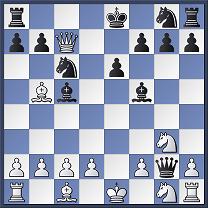 instead of my dreadful 9 Qf4? I could have established a clear plus by 9 Nxf5!. A computer had instructed him thus. At move nine.
instead of my dreadful 9 Qf4? I could have established a clear plus by 9 Nxf5!. A computer had instructed him thus. At move nine.
Even with an IQ of 180, Dr Nunn observed how analysis with computers had revealed to him just how limited we are to patterned thinking. When commenting on the 19…Bh6!! of his win over Kuligowski from Wijk aan Zee, 1983 he noted that in complex positions one must look at every possible move, and Dvoretsky also observed that in very sharp positions one move may change everything.
When I gave Miles the queen he was ranked ninth in the world and had 54 minutes left on the clock to reach move 40 to my 16. Even he quite overlooked 21 Rd3!, 22 Nxf5! and 24 g4!!.
And each was an only move.
‘You must take your opponent into a deep, dark forest where 2+2=5, and the path leading out is only wide enough for one.’
Mikhail Tal
But for these calculating engines everything is clear in even the most verdant setting. The outstanding characteristic of the computer move still remains the surprise and accurate tactic. When commenting on some (mutual) massive miscalculations in a complex game with Hans Ree, Speelman observed that such errors were easily made ‘in the heat of battle’.
Perhaps the definitive moment in the eclipsing of man by machine was the first match game when Deep Blue grabbed a distant Kasparov pawn, having simply calculated that it could withstand his attack.
Take for instance Larsen´s 32nd move in the first game of his 1971 Candidates match with Fischer.
Fischer – Larsen
Denver, 1971
A pivotal point of both game and match.
32…Qxc3 was given ? by both Timman and later ?? by Speelman before Kasparov gave it ? in his book on his predecessors.
They all criticised Larsen for his optimism and said that by ceding Fischer a passed a pawn he gave him the game. Play continued
33 Rg1+ Kf6 34 Bxa7 g5 35 Bb6 Qxc2 36 a5 Qb2 37 Bd8+ Ke6 38 a6 Qa3 39 Bb7 Qc5 40 Rb1 c3 41 Bb6
But computer analysis by Charles Sullivan posted by Muller at www.chesscafé.com suggests 32…Qxc3 actually deserves an exclamation mark and that after 33 Rg1+ Kf6 34 Bxa7 g5?? was the fatal error and Black could have demonstrated equality via 34…g6, 34…Ke6 or 34…Ke5.
All three GM commentators cited instead 32…a5 33 Bd4 Kh6 34 Rf1 as probably equal and certainly a better chance.
But the computers now view that as definitely superior for White.
34…g5 looks by far the most natural move on the board, and Timman and Speelman have each been ranked in the world top five whilst Kasparov was Kasparov.
But their conclusions, rational enough, were reached without using computers.
In the cold light of a Stockfish 14 day I conclude that my queen sacrifice with 19 Nxe4!? was sufficient.
21 Rd3! was the only way to validate it. And of all the moves I made in my life it remains the one of which I am the most proud.
My wife observed a certain symbolism in it all.
Chess is so difficult a game. And it is now played properly not by men but by machines.
I would (still!) welcome critical comments from Kingpin readers.
(Updated September 2023)

